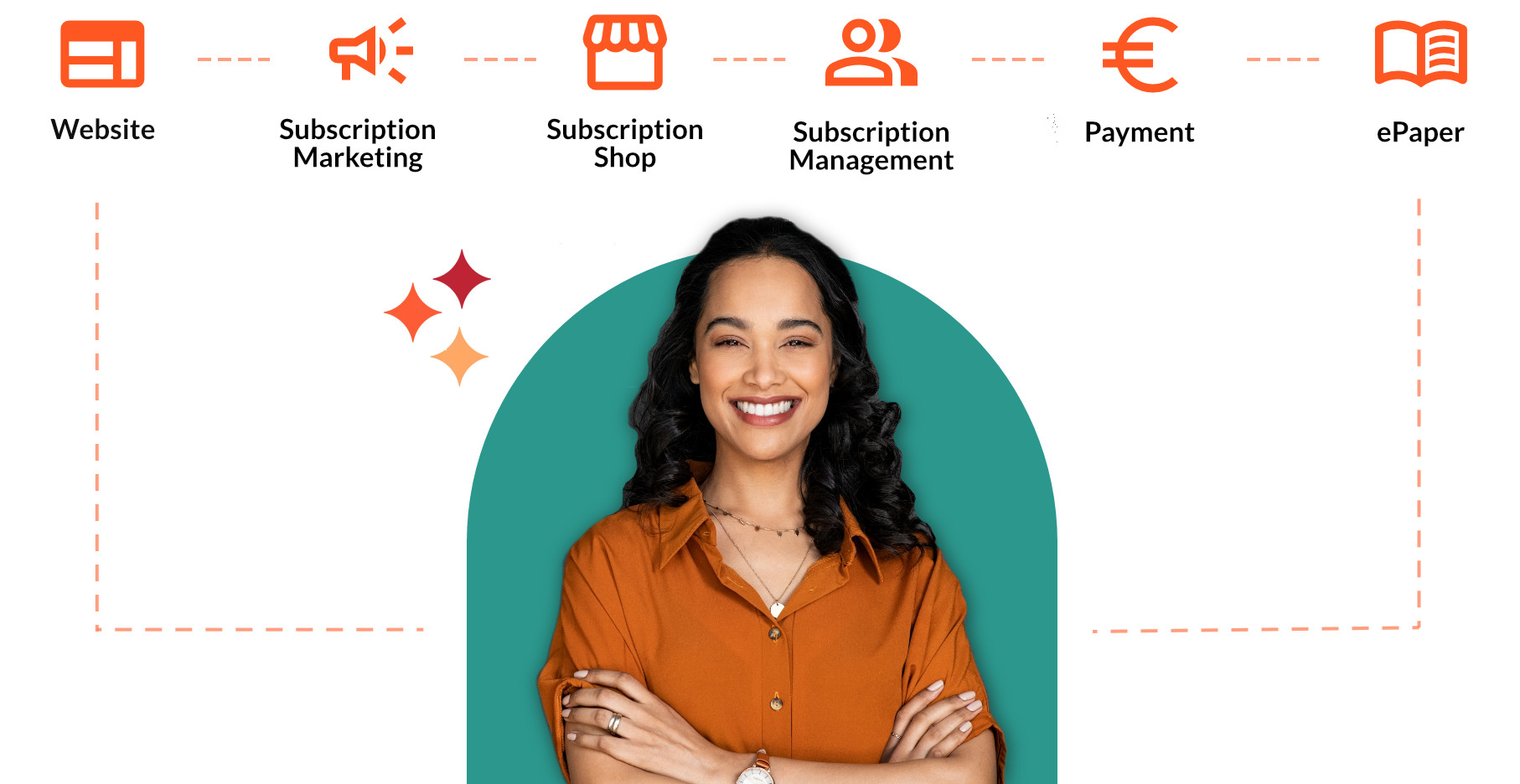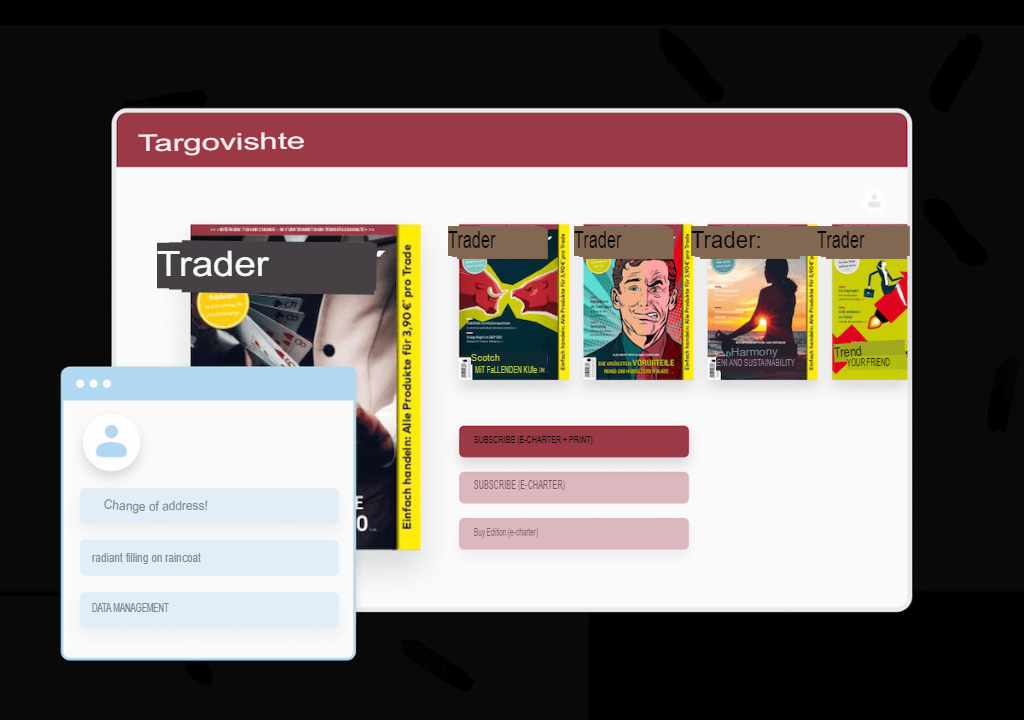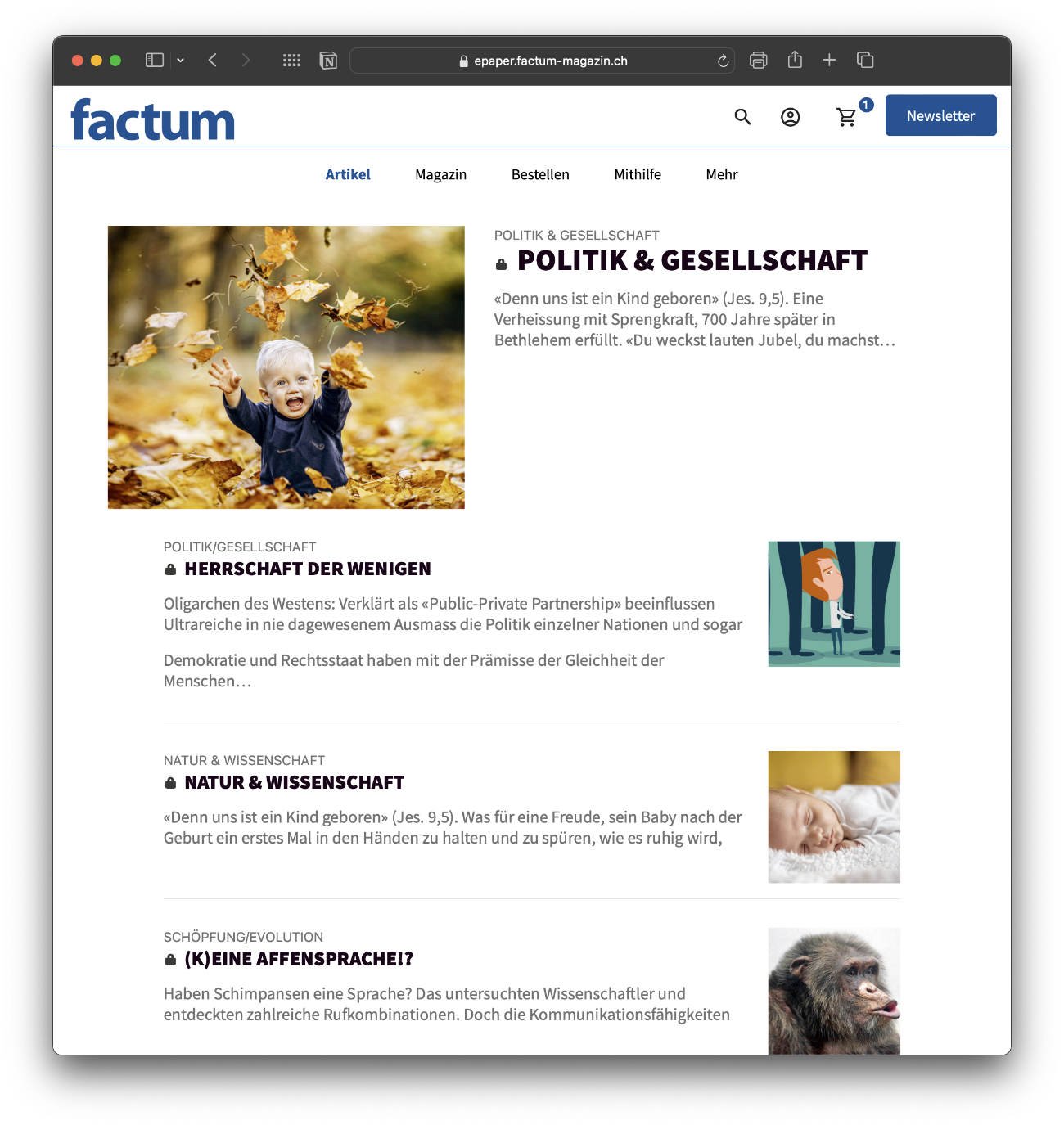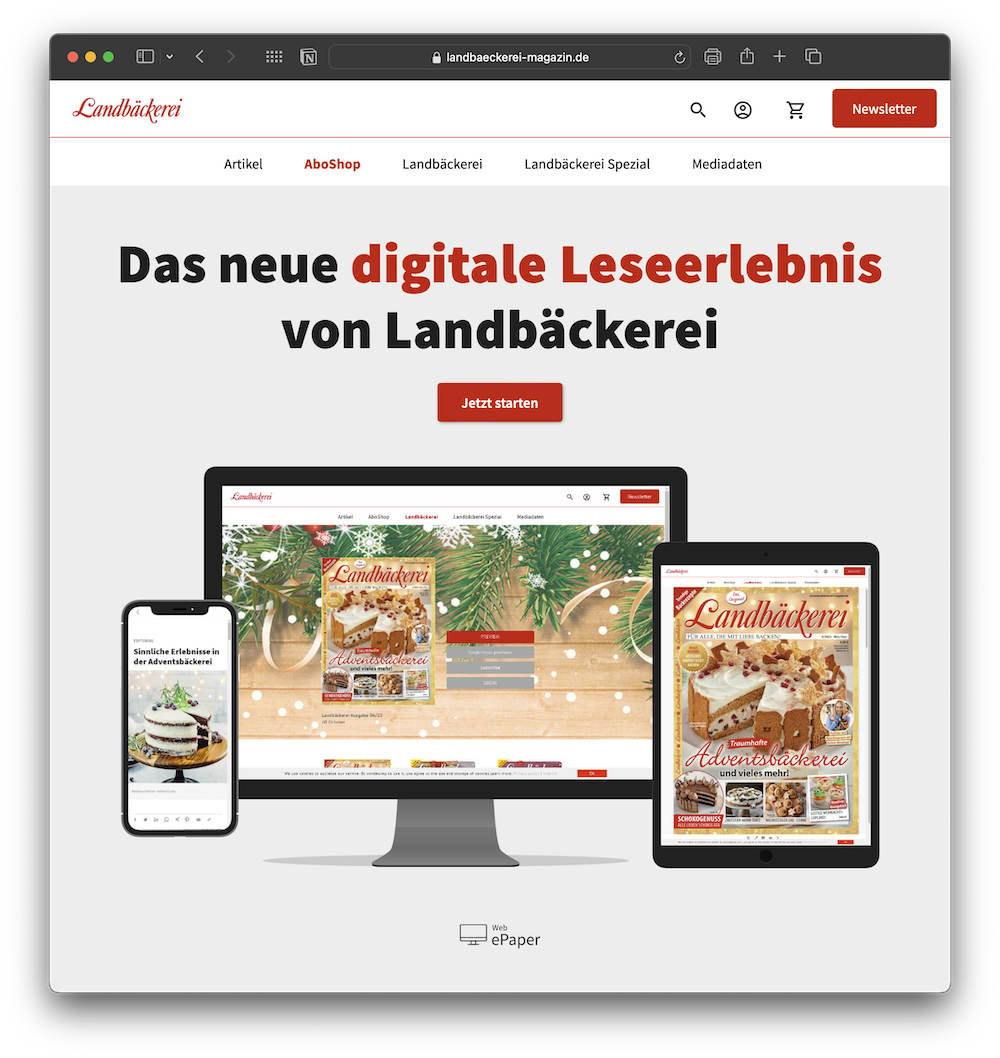Digital publishing autopilot
Smarticle OS is the operating system for publishers in which all processes relating to the paywall website, subscription acquisition, management and billing for print and digital are automated.

New website. New paywall. New subscription management. Everything on autopilot.
Give us your magazine PDF. We'll turn it into your website.
So automatic. So simple. So fast. So beautiful.
With each new print edition, the articles on your website are updated automatically. No touch publishing.
More than 250 Trade and special-interest magazines trust us.
 |
 |
 |
 |
 |
 |
 |
 |
 |
 |
 |
 |
 |
 |
 |
Start now for free
You only pay a revenue share when you earn money.


With the introduction of Smarticle, Schwengeler Verlag has launched a digital offering as an ePaper with an innovative reading mode and a subscription store with integrated payment, thereby increasing the accessibility of its content and attracting new readers.


Case Study Phoenix Graphic Magazine
Hello and welcome to a new "Smarticle" case study. Today with Christian Meier from "Phoenix-Verlag" and his "Grafikmagazin". Hello Christian, thank you for taking the time. Why don't you briefly introduce yourself?
Yes, my name is Christian Meier, I am the managing director of "Phoenix-Verlag" and we publish the "Grafikmagazin" for graphic designers. I'm looking forward to talking to you today.
Christian, tell us, how did you handle the topic of subscription management before you started with "Smarticle"? How did you do that?
We made a well-known design magazine in Germany for 20 years. The owner then closed it down. We see ourselves a bit as the successor to "Novum World of Graphic Design". Our magazine specializes in printing and finishing. We make sure that our magazine looks good and focuses on print. This means that our editorial team has to be very focused, because printed content is here to stay. That's why we were lucky to have a great print shop, F&W Druck und Medien, who worked with us to develop an online store. We did everything together in terms of subscription management and sales. But at some point, we couldn't go any further because we had to invest so much time in maintaining the data, designing inquiries and writing reminders. That was the reason why we were looking for a professional solution at the time.
Ich kann mir vorstellen, dass das eine Menge Arbeit war, die manuell erledigt werden musste. Sicherlich war es nicht einfach, da den Überblick zu behalten.
Ja, genau. Das war eigentlich der Auslöser, mal am Markt zu schauen, was wir finden, was uns eben hilft, diesen Aufwand zu minimieren oder in Grenzen zu halten. Da sind wir dann auch auf euch gestoßen.
Ich habe eine Frage, bevor wir mit „Smarticle“ starten. Wer hat denn diese ganze Arbeit geleistet? Hattest du dabei Unterstützung oder hast du das alles ganz alleine gemacht?
We were very lucky to have a really great employee at "F&W", our print shop. I really want to mention Matthias Froners here, because he was really committed. And my colleague Tobias Holzmann, who also helped out and does the web design. He also designed the web store. And I actually took care of everything financially. Several people were involved and every time the invoice run was due, the effort was the same. So we were really busy for two weeks with the invoice run. And the second thing is the follow-up action or when someone wanted to have their name changed at the postal address. I was always there in person.
That really is quite a lot. And you said that you then went on a search and came across "Smarticle". What interested you about "Smarticle" in general at the beginning? What made you curious?
The focus of your website on trade journals convinced me. We also see ourselves as a trade journal. We are not purely a trade journal, as we are also a consumer magazine, but the website still convinced me. I heard some interesting things there, for example that users can manage the subscription themselves and that there is an automatic reminder system. I thought that was very important.
We then got to know each other and had our first conversations. Looking back, what were the decisive reasons for you to choose "Smarticle" back then?
You'll laugh, when we uploaded a PDF magazine for the first time and saw what kind of ePaper with article reading mode you could conjure up from it, that's when you really had us. That gave us a lot of food for thought. We really do see ourselves as a magazine that focuses on print and is very much about the feel. But I've also always secretly been looking for ways in which we could somehow expand this in terms of media. And there were simply functions that you didn't actually announce in such a big way, but that really excited us. For example, that if you have a subscription, you can search across all issues. This is actually the ideal cross-media extension for our readers. I would also like to explicitly address students who can use this tool. I can search for topics for my studies here. Grafikmagazin is a thousand times more citable than any Google article. We particularly liked that and thought it was actually a great thing and something we could do for our readers. This is of course very important and yes, we can also create new value.
Wow, exciting, okay. Then we started the onboarding process with us. How would you describe this collaboration up to this point, how was the onboarding for you, how did you perceive it?
First of all, we're a bit of a difficult bunch, because a graphics magazine like this depends on everything being graphically perfect. In other words, our readers or the people who visit our website expect us to produce a visually flawless product. In other words, we naturally attach much, much, much more importance to this than a fire department magazine or a police magazine... You know what I mean. As for the onboarding process, I'd like to say that it worked incredibly well and we actually managed to create a store that really does credit to a graphics magazine and I was very pleased that we managed to do that and now we've been online for a week and it really works, people are buying through it, so everything fits.
Great, I'm really pleased about that, and thank you very much for the feedback here. What is the area that brings you the most added value at the moment? Can you say anything about it yet?
Yes, it's actually a bit difficult after a week. I can simply say that in terms of corporate strategy, it is of course the topic of ePaper. This is of course a completely new playing field for us, where we are actually also playing internally. How can we take this cross-media approach even further? But it's something that we really like, because it's really something new for our magazine. And something that, if you had asked me a year or so ago, we wouldn't have had on our radar at all. And that's something we were really pleased about.
I look forward to continuing to work with you and to developing together. Have you already thought about how you want to measure certain successes?
As an entrepreneur, success is relatively simple. The cash register has to ring. Our magazine has to be successful with our readers for us to be successful. We sell our content because it is valuable. We want our sales to be right. To achieve this, we offer our customers high quality and easy ways to be inspired by our magazine. We want our students to be more successful in their studies. We want to drive these things forward and that should be our goal now. We also want to know what people are looking at and what interests them. We've already talked about that. We want more information to see what people are looking at. We want to know what is popular and what is not. We also want to know how long people watch something.
Yes, we want to help you to be successful. We look forward to being on the road with you. Dear Christian, let's take a step back from the specific collaboration with "Smarticle". When you think about the future, the prospect of 2, 3 or perhaps even more years. What do you think a publisher will need from the technologies? What will be necessary for you to be able to operate in the best possible way?
In terms of technology, that's a bit difficult for me, I can't say too much because we actually have the printed magazine at the center of our sales, that's the heart of our company. We would be delighted if we could offer people the opportunity to better understand and use our content online. We could provide them with another helpful tool for this. Another exciting topic is, of course, artificial intelligence. You know, we've talked about it before. That's obviously something exciting with a team of four people. I see it mainly in sales and administrative stories like this. It really is a great tool that helps us to process things faster. I don't think we'll use AI a lot in the editorial area, but we will in analytics, marketing and so on. We would be very happy if we could get one or two things off the ground together with you over the next few years.
Thank you very much for your interesting assessment, your feedback and the time you have taken. I wish you, and of course us, continued good cooperation and much success. Many, many thanks.
Thank you very much, dear Arsalan, for the opportunity and yes, see you soon!

"As a small publisher, I can enthusiastically say that the integration of Smarticle has revolutionized our work processes. Handling the subscription business is now easier and more professional than ever before. Our readers benefit from a modern and convenient reading experience that they love. Thank you, Smarticle for this innovative solution!" Paywall website


Case Study New Lusatia
Hello everyone and welcome to a new "Smarticle" case study! Today we have Christine Keilholz from "Die neue Lausitz" as our guest. Hello Christine, thank you for taking the time to give us some feedback. Would you like to briefly introduce yourself?
Hello, thank you very much, my name is Christine Keilholz and I am the editor-in-chief of the new Lausitz. This is an e-mail briefing that is published in Cottbus once a week. It's about structural change. We've been doing this for two years now. Back then, I founded a small publishing house called Förderbrücke together with a few colleagues. We publish "Neue Lausitz", our first product, which we launched as a newsletter
Great, thank you! You've been on the road with "Smarticle" for two months now. How did you handle the topic of subscription management before you started with "Smarticle"?
Yes, we treated it very provisionally beforehand, because of course you need a good system. It simply has to work. You don't always have that from day one, and then you might leave a few questions unanswered and try to sort everything out manually, because you have to get through all the processes. And that's how we did it. So we started with a small team of three people and did some of the tasks manually that "Smarticle" now solves for us automatically
Okay, I understand. And what would you say? What was the division of tasks like? Was there one person who mainly took care of the tasks?
That was already split between the three people, so essentially content creation of course. We have authors who write it, editors, then the whole subscription administration area, we have an employee who does the back office and yes, then the newsletter mailing every Monday because we are published on Tuesdays. A person who specializes in digital processes took care of that. We actually split it up between three people because we also had three different systems that we had to reconcile
Okay, and when you came across "Smarticle" at the end of last year, what was it about "Smarticle" in general that initially interested you?
I think it's great that you get everything from a single source. That makes a lot of things easier. When it comes to how you get a publication out, no matter how often it appears and no matter what the content is, you obviously need a good content management system for the articles from the PDF files. You also need to have a newsletter distribution system. And in our case, that's very important. Everything that has to do with administration can be automated, but it still has to be easy to use. And you have to be able to answer questions at any time. Yes, I recognized all that in "Smarticle" at first glance. Then there's another thing that's a bit special. We sell multi-user subscriptions, so a subscription for a whole office, a whole team. 15 people can get licenses or five people, depending on where it is. We do very well with that. An administration system has to be able to map this as well
Okay. And of these topics that you initially saw with "Smarticle", i.e. everything from a single source in one system, where did you see the decisive reasons for ultimately choosing us?
Well, there were also a few things that we simply didn't have yet, e.g. a subscription store, which we also did manually, and that works for a while as long as you are a regional medium and many people already know you anyway, but when it comes to increasing your reach beyond these small initial customer groups, then of course you also need professional processes, and that's where a subscription store makes a lot of sense, so that's what "Smarticle" has. And then, of course, the connection: So someone comes and buys a subscription and it's immediately in the system and the reader gets their newsletter straight away. So, if it works like this, then of course it's something that makes our work a lot easier and then we can concentrate on what we set out to do, namely researching good content. So yes, this link between the subscription store, administration and dispatch and a website that provides our customers with a good overview, I thought that was crucial
Okay, good. As I said earlier, you'll be on the road with us for two months. The onboarding was in advance. How did you experience the collaboration, especially in terms of onboarding? How was it for you?
So the collaboration is very good. I also feel that I'm in good hands with the processes, where of course you don't have a complete overview of the details. It's just important to have someone on hand who can implement it well from a technical perspective. And of course that was also the case, there are always problems that arise when you switch to a new system. You have to import everything, move everything and there's always a problem somewhere. And so far we've always found solutions, so I'm quite happy about that. So I can say that once the system is running smoothly, it's a very good system.
Our readers used to receive a newsletter that contained several full-length texts. Of course, that also had its appeal. Now you click on the article preview, go to the website and can register there with your e-mail address. This can be done without any major hurdles, which all our customers understood immediately, and it is also more in line with what users expect from digital media content
Okay, you said there are many things that are already good. During onboarding, we also realized that it is normal, if I understood you correctly, to come across areas that may pose new challenges. So far, we have always found solutions, but I also hear that there are still a few things that can be optimized, so we are also planning onboarding videos to help. In all of this, where would you say is the area where you currently see the greatest added value that is already beneficial for you?
Well, the added value is first and foremost external, that's always the most important thing. It's already a very professional appearance that we have there, so this combination of CMS and newsletter, how it comes across, how it looks, that's very good and it's a simple look, it's a clear structure that also suits our content very well. This is already an added value and also outwardly this usability for our readers, as I described it, they can simply click in, we think that's good. And then, of course, the most important thing for our processes is that we are a small team, we are still a relatively new medium that is in the process of gaining a higher profile, which of course brings with it many new tasks. You don't have the freedom to worry about technical details, so you're happy if you have a system that works well. As I said, it's not running completely smoothly yet, but so far the problems that have arisen have been solved, so I'm very confident about that
Okay, that means that readers definitely like the fact that the appearance has also been improved. To summarize: State of the art in terms of technology and reading style. If you go a little further. Where would you say the future is heading, in terms of technology, in terms of your readership? What features and functions do you expect for the future, for your readers.
Yes, I would like a bit more overview and analytics in the processes. Yes, you need a proper dashboard where I can see that the newsletter has gone out, that so and so many people have received it, so that you simply have more control over what happens, that would be important to me. Apart from that, where is the journey going? We started two years ago with a purely online medium, at a time when it was just right, so now it would be too late, there are definitely a lot of new start-ups that are trying this out. We don't work so much with ePaper, but more with newsletters. The newsletter is in the process of establishing itself as a standard medium. At least that's my perception. It's easy to get people to understand that the magazine no longer arrives in their letterbox, but by e-mail. Word has gotten around in the last two years since we've been here and it's also easy to understand. In this respect, I really see opportunities, especially for us, we are a regional medium in Brandenburg and Saxony, so many authorities read us, people read our content on business because we have also specialized in content and then there is also a whole region where there is always the discussion, can you still reach people with media? And how do you get there? And that's where a newsletter is great, of course. That's actually the thing to get in there
Okay, interesting. Yes, analytics is a way of measuring success and seeing how many people open and read something. So you can understand everything better. You said that you want to retain control. That's already on our roadmap and we're happy to continue working on it. Yes, it's exciting to see how you're doing now. Thank you for your feedback. I wish you every success with "Smarticle" and look forward to the rest of your journey this year. Thank you very much

"As a small specialist publisher in public administration, I can only rave about the revolutionary effect of Smarticle. With this new digital offering, we have not only increased our reach, but also significantly increased our open rate. It's amazing to see how Smarticle has helped us reach our readers even better."
Paywall website


Case Study KLM
Hello and welcome to a new "Smarticle" case study! Today we have a very special guest: Peter Baranec from "KLM". Dear Peter, would you like to start by introducing yourself?
Yes, with pleasure. My name is Peter Baranek. I'm 61 years old and wrote my first newspaper article when I was 16. I've been working as an editor for radio and print media for almost 35 years. I've worked for Motorpresse, Deutsche Presseagentur and Saarländischer Rundfunk, among others, as a presenter and news editor. I've been self-employed since 2022. KLM has been around since 2003 and has undergone two relaunches so far. In 2022, I completed further training in digital publishing and since 2023, KLM has been published entirely as an e-paper, at the request of our readers. Our readers have told us that they are now digitizing their mailrooms as part of the legislation and want less print. So we should switch to e-paper. As of today, the KLM is even available with moving images, just like Harry Potter in the Daily Prophet. I want people to be convinced by the KLM.
That's exciting Peter, I would like to know how you dealt with the topic of subscription management before the launch of "Smarticle".
Well, that's really embarrassing because KLM is a really difficult magazine. I knew from the beginning that readers wouldn't be able to subscribe to the magazine because even back then the budget situation in the cities and municipalities was pretty tight. So I thought that I would have to give the magazine to readers as a gift and refinance it through advertising. However, there were also individual subscribers right from the start, such as the Federal Minister of Finance and a few dozen others. But we simply managed them manually, i.e. my assistant and I did the free subscriptions and the other half was simply delivered by post from the print shop.
This means that all these steps were done by hand. I think you also used an Excel list, in table form, and tried to keep track of everything. What were you particularly interested in when you came across "Smarticle" or switched to us?
I thought that the switch to e-paper would give me an opportunity to broaden the magazine's reach. After all, it can now be obtained digitally in the subscription store, which is accessible to everyone. I hope this will enable me to reach more readers and perhaps also attract new readers who are interested in municipal issues. That was the idea and "Smarticle" was also the only provider to make a fair offer without fixed costs based purely on revenue share. This was probably also due to the fact that we more or less both wanted to grow together and still do.
Yes, okay, then we've understood your basic idea and I'm pleased that "Smarticle" was able to help you implement it. Apart from the attractive offer, as you said, were there any other decisive reasons for choosing "Smarticle"?
Yes, the appearance of "Smarticle" was decisive for me. I was really enthusiastic and thought it was great that we said we wanted to grow together. That was actually the deciding factor. There were other offers that weren't as clear to me and weren't as nice as I had imagined. That's why I ended up with you now.
It's great that we were able to make you a transparent and attractive offer and that you got started. You started with "Smarticle" last year. How would you describe the review of the collaboration? How did the onboarding go for you?
We really underestimated how much work onboarding involves. The planned month turned into almost three until everything was completed. But then it worked smoothly until today. And that's really good, it's stable and everything is fine. The collaboration, yes. I think we have a relatively good, almost collegial relationship as equals. We work together and try to achieve the best together.
Thank you, I'm very pleased that you feel that way. We are currently working on creating help videos for onboarding to make the process even easier and smoother. What is currently the area that offers you the most added value? Is it making your work easier, is it technology, is it something where you say that's already the added value I see?
Yes, that's a really difficult question to answer because it's a completely new medium for us and I can't compare it to anything else. Because in our particular case we enrich the magazines with multimedia such as links, images and videos, it's obviously more work for us now than it used to be with print. I now have to think about many more things, such as links. An interactive PDF is simply more than a printable PDF. There's a lot more going on, so it's clearly more work. If I make a PDF replica, I just have to upload it. Then I know, okay, now it's in good hands, the rest is fully automated. I really don't have to worry about anything anymore.
Great, that means that in addition to the automation that "Smarticle" offers, you have decided to invest additional effort in the follow-up to prepare the e-paper in multimedia format in order to create even greater added value for your readers. Have you also found other ways to monetize advertisers or similar?
Yeah, sure. Yes, I've been talking to some advertisers for three weeks now and they found this "Daily Prophet" theme like Harry Potter, this "I love magic", I think he said when he opened the newspaper, this experience of seeing magazines in a different way, the fact that you now swipe on the tablet instead of turning the pages, is really practical. But it would also be cool if the pictures didn't just stand still, but you could also see text and perhaps a statement or a product in 360 degrees in addition to the reading experience. These are things that can be valuable not only for an Amazon purchase, but also in a magazine. That also goes down well with advertisers. They are now thinking in a completely new way about what they didn't do before because there was no solution for it
That sounds great. You have clear added value and can monetize advertising customers more. At the same time, you can offer your existing readers even more content than was possible in print. You're happy to put up with the extra effort. In addition to the digital option of passing on your content, i.e. marketing the whole thing purely digitally in the form of an e-paper, what other "Smarticle" modules are you currently using?
Not at the moment. At the moment that's all, but I know that you are constantly offering, trying out, introducing new things and so on. I'm always excited to see what I might be able to use next
Great, that's fantastic. We would like to support you and see how we can contribute to increasing the readership, increasing accessibility and making it even easier to access. Nice. Dear Peter, thank you very much for your feedback so far. It's really exciting how you're using "Smarticle" and how you want to enrich your readership here with the technology. We would like to continue to support you. Thank you for choosing us and thank you for your time today.

Smarticle OS enables Teichmann Verlag to reduce the effort and costs involved in managing subscribers and maintaining its publishing website.
New sources of revenue through digital products and the new paywall website.

Book publishing assessment now
Click on "Complete quiz" to find out what is possible for your publishing house.


